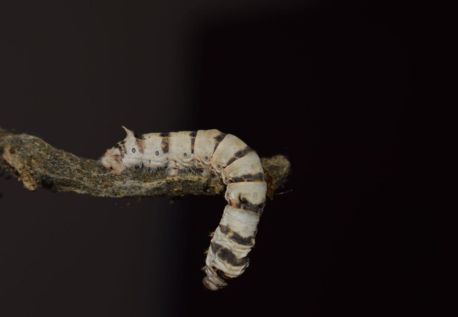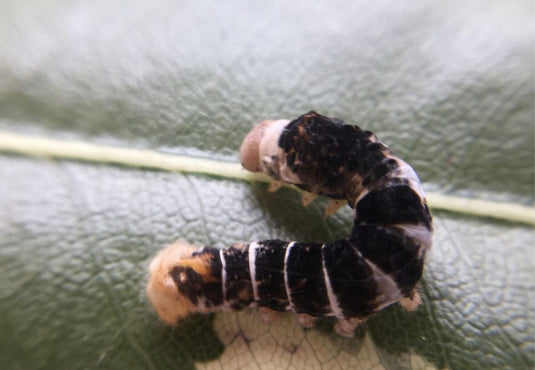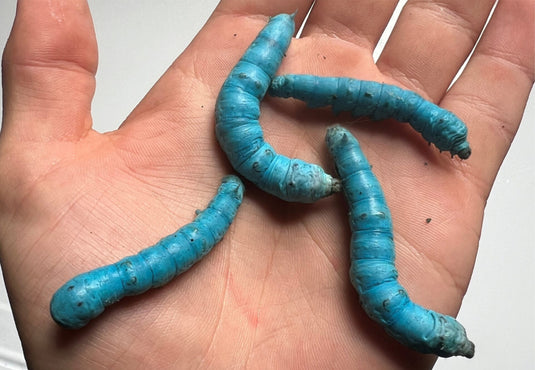Silkworm Information
Got questions about rearing silkworms? Check out our FAQ page.
Rearing silkworms can be a rewarding and educational experience, offering insight into the fascinating life cycle of these remarkable creatures. From caring for tiny hatchlings to witnessing the transformation into cocoons and eventually silk moths, each stage requires specific attention and care.
Whether you're interested in sustainability, education, or the silk production process, understanding how to properly rear silkworms is essential.
Silkworm care
Before starting your journey with silkworms, it’s essential to learn the proper care techniques. While it may seem a bit tedious at first, you'll soon get the hang of it and gradually become an expert, picking up useful tips along the way.
Once your silkworms hatch, they will need care and attention for the next 20-35 days. The more they are fed, the faster they will grow. Housing your silkworms is straightforward: small numbers (50-100) can easily be kept in shoeboxes, while larger quantities can be stored in trays.
As your silkworms grow, ensure they have enough space by spreading them out. This helps them live comfortably and reduces the risk of disease, to which silkworms, like humans, are susceptible. Make sure to clean their frass (droppings) daily, a process known as "bed cleaning."
Tip: Line the bottom of your shoeboxes with paper or a towel. This makes it easy to lift out and dispose of the frass when it accumulates.
Feeding Mulberry Leaves to Silkworms
Small silkworms eat less than older ones, so it's important to adjust their feeding accordingly. Add leaves at least once per day, and ideally two to three times daily when the silkworms reach full size. Feed them in the morning, midday, and evening. If the leaves wilt on hot days, swap them out more frequently. To reduce waste and the chance of disease, feed smaller amounts at more frequent intervals.
If you prefer not to transfer each silkworm when changing leaves, place a piece of mesh over the box and put the leaves on top. The worms will crawl up through the mesh to the fresh leaves. After 25-30 days, your silkworms will start consuming more mulberry leaves than ever. Soon after, they will be ready to start cocooning, reaching over 10,000 times their original weight.
Interesting Fact: In spring, when the air temperature drops at night, silkworms struggle to digest their food. To counter this, many commercial farms increase the quantity of feed in the mornings and raise the temperature in the evening.
Feeding Silkworm Chow
Using Silkworm Chow instead of mulberry leaves is becoming increasingly popular among silkworm rearers. The process is simple: mix the food upon arrival and store it in the fridge. While Silkworm Chow is not as nutritious as mulberry leaves, it is a practical option, especially in urban Australia where mulberry trees are hard to find.
The difference in silkworms raised on Chow is minimal for most rearers. The primary difference lies in the quality of silk produced, which mainly concerns those raising silkworms specifically for silk production.
When feeding Chow, we recommend slicing the food rather than providing a whole block. This increases the surface area for the silkworms to feed on, reducing crowding and the likelihood of disease outbreaks. Detailed instructions on how to best use Silkworm Chow will be provided with your purchase.
Smaller silkworms require extra attention because they can easily get caught in old leaves or frass. Without proper care, you might end up with less than half the number of cocoons compared to the number of hatchlings.
Here are a few simple strategies to improve the survival rate of your young silkworms:
- Regular Cleaning: Ensure their living area is cleaned regularly to prevent buildup of frass and old leaves.
- Manual Transfer: Manually transfer the kegos (1st instar silkworms) onto fresh food instead of waiting for them to move on their own.
- Diet Transition: Start rearing them on Silkworm Chow, then transition to mulberry leaves in the 2nd or 3rd instar.
By following these steps, you can help ensure a healthier and more successful rearing process for your silkworms.
Once your silkworms have spun their cocoons and emerged as silk moths, they will require a bit of care to ensure their well-being and the continuation of the silkworm lifecycle. Provide a clean, dry, and spacious environment for your silk moths, such as a simple container or box with a breathable cover. Ensure the housing is escape-proof, as moths can be surprisingly mobile.
Silk moths do not eat or drink once they emerge from their cocoons. Their sole purpose at this stage is to mate and lay eggs. Place male and female moths together in the same enclosure to facilitate mating, which can take several hours. Once mating is complete, separate the males and females to prevent unnecessary stress.
Female moths will lay up to 500 eggs after mating. Provide a suitable surface, such as paper or cloth, for them to lay their eggs on. Collect the eggs carefully once they have been laid. Silk moths have a short lifespan of about 5-10 days. During this time, they will focus on reproduction. After laying eggs, the female moths will naturally pass away, and males will also die shortly after mating.
Regularly clean the enclosure to remove any waste or deceased moths. This helps maintain a healthy environment and reduces the risk of disease. By following these steps, you can ensure the well-being of your silk moths and successfully manage the silkworm lifecycle for future generations.
As moths, your silkworms will lay up to 500 tiny eggs. Initially, these eggs will appear yellow, but after a few days, the fertile ones will turn blue. However, these eggs won't be ready to hatch immediately; they need to go through a cold period first. In nature, this cold period is winter. However, thanks to Silkworm Chow and heating, you can raise silkworms any time of the year.
To simulate winter, place your eggs in the fridge for at least 3 months but no longer than a year. After this period, your eggs will be ready to hatch.
Note: Once the eggs have been refrigerated and then taken out, do not put them back in the fridge. They will have already begun the hatching process, and returning them to the fridge will kill them.
The best time to start rearing silkworms is after the beginning of spring or when your mulberry tree starts to sprout.
Feed your silkworms year-round

Rear silkworms year round, no matter the weather


Join our online silkworm rearing community
To share your experiences, for more rearing tips, and to better understand how to care for your Silkworms, make sure to join our online rearing community on Facebook here.
















